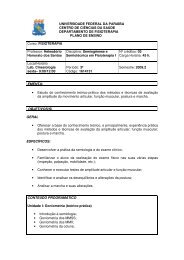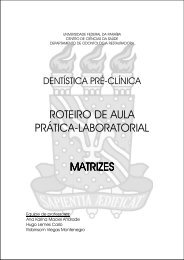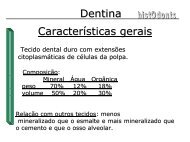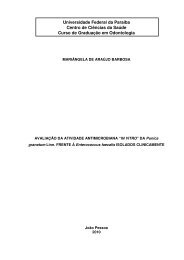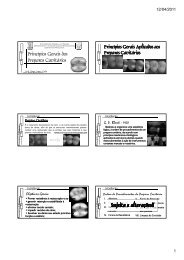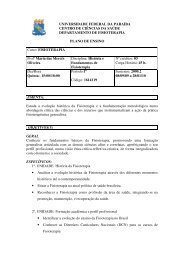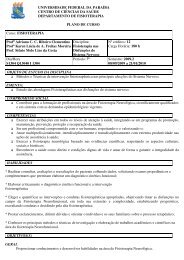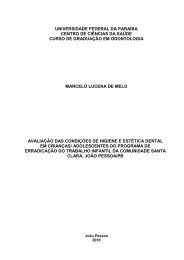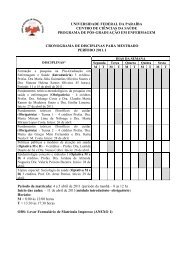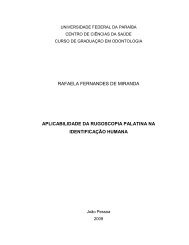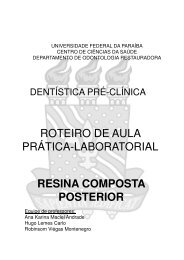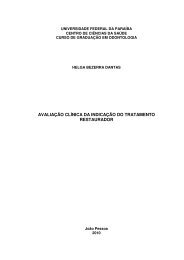13. interpretação radiográfica de lesões nos maxilares por alunos ...
13. interpretação radiográfica de lesões nos maxilares por alunos ...
13. interpretação radiográfica de lesões nos maxilares por alunos ...
You also want an ePaper? Increase the reach of your titles
YUMPU automatically turns print PDFs into web optimized ePapers that Google loves.
P á g i n a | 9ABSTRACTThe aim of this study was to evaluate the interpretation of jaws lesions in thepanoramic radiographs, by graduation stu<strong>de</strong>nts of Dentistry, after the DentalRadiology course at UFPB. 32 stu<strong>de</strong>nts were part of the sample that was divi<strong>de</strong>d intotwo groups. Group I consisted of 8 stu<strong>de</strong>nts in the sixth and 8 stu<strong>de</strong>nts of the seventhperiods and group II, formed by 8 stu<strong>de</strong>nts of the ninth and 8 stu<strong>de</strong>nts in the tenthperiods. Each stu<strong>de</strong>nt evaluated 23 scanned images of panoramic radiographs,using LCD monitor, 17 , of which only 6 did not show any lesion, and the other 17presenting cases of radicular cyst, <strong>de</strong>ntigerous cyst, Stafne cyst, periapical cymentaldysplasia, cystic ameloblastoma and odontogenic keratocystic tumour. Evaluatorsrespon<strong>de</strong>d to a questionnaire addressing the presence, location and diag<strong>nos</strong>is oflesions studied. Groups I and II presented rates of correct answers regarding thepresence or absence of lesion, sensitivity and specificity of 88.9%, 94% and 83%,and 91.6%, 91% e 81% respectively. For the location of the true-positiveassessments, group II (81.5%) had a higher percentage of correct answers that thegroup I (79.3%). There was lower rate of correct true-positive lesions in the anteriormaxilla. For the diag<strong>nos</strong>is of false-positive evaluations, the anterior mandible andradicular cysts were the most selected. Taking into account the percentage of correctdiag<strong>nos</strong>is as to the true-positive assessments correctly located, the rate of correctanswers was 51.1% in group I and 50.3% in group II. The periapical cementaldysplasia, the <strong>de</strong>ntigerous cyst and the Stafne cyst were the lesions that had higherpercentages of correct answers, while the cystic ameloblastoma had the lowest. Itwas conclu<strong>de</strong>d that the stu<strong>de</strong>nts groups have good rates and similar levels in theinterpretation of panoramic radiographs. The anterior and posterior region ofmandible, are the most susceptible to false-positive diag<strong>nos</strong>is. Familiarities with thepathologies of maxillary help in preparation of a presumptive diag<strong>nos</strong>is by means ofX-rays, but can also influence the false-positive diag<strong>nos</strong>is. Knowledge ofradiographic anatomy and pathology is im<strong>por</strong>tant for radiographic interpretation. Thepanoramic radiograph is an im<strong>por</strong>tant tool in the preparation of the presumptivediag<strong>nos</strong>is, but should be used carefully, to display shadows and distortions that canmimic bone lesions.Keywords: Panoramic Radiography; Diag<strong>nos</strong>tic Imaging; Radiographic ImageInterpretation Computer-Assisted; Digital Radiography.



